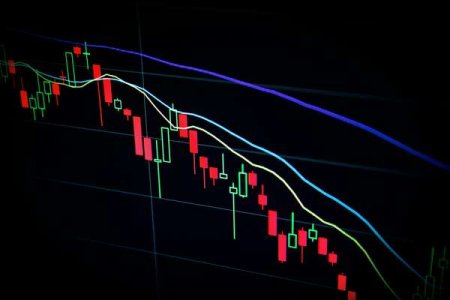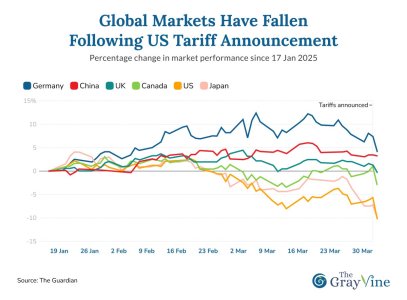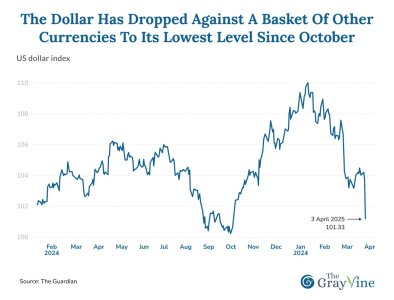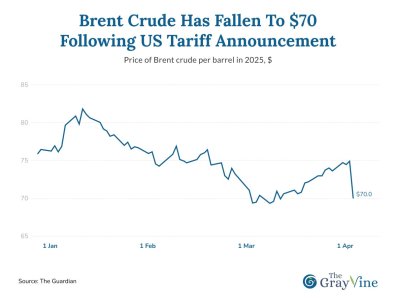Trillions lost in a day–Wall Street plunges amid growing global tensions
- Replies 0
The global financial landscape is experiencing significant turbulence following a dramatic policy shift out of Washington.
A bold move tied to sweeping trade measures has triggered deep ripples across international markets, contributing to a historic drop in US stock value—estimated in the trillions.
Investors are on edge, and governments around the world are closely monitoring the unfolding impact. Whether you're a seasoned investor or just starting to dip your toes into the market, understanding the implications of these recent events is crucial for protecting your financial future.
The global financial landscape has been significantly disrupted by President Donald Trump's recent tariff implementations, leading to a substantial decline in market values and raising concerns about a potential US recession.
In a move that has unsettled international markets, President Trump introduced extensive tariffs ranging from 10% to 50% on imports from both traditional allies and adversaries. This action resulted in approximately $2.5 trillion being erased from Wall Street, with share prices in financial centers worldwide also experiencing declines.
Economists have expressed that these sweeping border taxes have significantly increased the likelihood of a severe global downturn and a recession in the US.'

International reactions have been swift and critical. China condemned the country’s "unilateral bullying" practices, while the European Union announced plans to develop countermeasures in response to the tariffs.
President Trump referred to the day of the tariff announcement as "liberation day," emphasizing his intent to overhaul the existing international trade framework.
The timing of the announcement appeared strategic, as it was made during a Wednesday evening Rose Garden address, potentially aiming to mitigate immediate market reactions.
However, significant market responses were observed when Asian exchanges opened hours later.
Echoing the market collapses seen during the peak of the COVID-19 crisis and the 2008 financial meltdown, the sell-off rippled worldwide, triggering steep declines across Asian and European exchanges.
The UK’s FTSE 100, a benchmark for top-tier firms, closed down 133 points (1.5%) at 8,474, marking its worst performance since August.
All three major US indices closed lower, recording their worst session since June 2020 amid the pandemic.
The technology-focused Nasdaq plummeted 5.97%, while the S&P 500 and Dow slid 4.8% and 3.9%, respectively. By midday, Apple and Nvidia—two of America’s most valuable corporations—had shed a combined $470 billion in market capitalization.
Libby Cantrill, head of US public policy at Pimco, a leading global bond investment firm, noted that investor anxiety was mounting as Trump showed little willingness to moderate his approach despite market chaos, though some still hoped he would negotiate with trade partners.
“There is likely a limit to how much pain he and his administration are willing to endure in order to rebalance the economy, but when that is or what that looks like remains to be seen,” she said.
“For now, we should assume that his pain tolerance is pretty high and that tariffs stick around for a while.”
Meanwhile, the US dollar plunged 2.2% during Thursday morning trading to a six-month low, reflecting eroding confidence in what had long been viewed as the world’s safest currency.
Deutsche Bank’s head of foreign exchange research, George Saravelos, cautioned clients about a potential “dollar confidence crisis,” stating, “The safe-haven properties of the dollar are being eroded.”
The steepest stock declines on Thursday hit U.S. firms with intricate global supply chains linked to countries targeted by Trump’s proposed new tariffs.
Apple, which manufactures most of its iPhones, tablets, and other devices for the US market in China, dropped 9.5% at the close, while other major multinationals like Microsoft, Nvidia, Dell, and HP also saw significant losses.
Commodities tumbled sharply, with oil prices plunging 7%, as worries over the global economic outlook intensified.
Source: CNN / Youtube.
Speaking to reporters on Thursday, Trump remained optimistic, stating: “I think it’s going very well. It was an operation like when a patient gets operated on and it’s a big thing. I said this would be exactly the way it is … We’ve never seen anything like it. The markets are going to boom. The stock is going to boom. The country is going to boom.”
He later added, “Every country is calling us. That’s the beauty of what we do. If we would have asked these countries to do us a favour they would have said no. Now they will do anything for us.”
However, Trump’s tariff proposal has drawn sharp criticism over the past day, with US lawmakers and international leaders condemning the move.
Senior Republican Senator Mitch McConnell labeled it “bad policy,” while Canada, a longstanding US ally, dismissed the tariffs as “unjustified” and “unwanted.”
The tariffs will disproportionately impact some of the world’s poorest nations, particularly in Southeast Asia. Cambodia—where 20% of the population lives in poverty—faces the highest regional tariff at 49%.
Vietnam was hit with 46%, and Myanmar, still recovering from a catastrophic earthquake and ongoing civil unrest following a 2021 military coup, was slapped with 44%.
Source: CNBC / Youtube.
Analysts cautioned that global apparel and footwear brands, which depend on Southeast Asian manufacturing, will see costs surge, leading to higher consumer prices worldwide. Stocks of major sportswear companies like Nike, Adidas, and Puma plummeted in response.
Experts warned that Trump’s policies could push US average tariffs to their highest levels since 1933, potentially triggering a recession and driving up living expenses for American households.
Trump’s chart of tariffs
The “reciprocal tariffs” shown during Trump’s announcement. “Tariffs charged to the USA” are defined by Trump and “include currency manipulation and trade barriers.
Trump's proposed trade measures would implement an across-the-board 10% tariff on all US trading partners starting April 5, followed by targeted tariffs as high as 50% on specific nations including China, Vietnam, and EU member states.
The independent Tax Foundation projected these policies would effectively create a “$1.8 trillion tax hike” for US consumers, which would lead to imports declining by $900 billion in 2025.
Researchers at Oxford Economics warned that while the measures would significantly impact the US, they could also drag global economic growth down to its lowest level since the 2008 financial crisis, excluding the peak pandemic years.
Countries scrambled to assess the potential fallout and weigh retaliatory measures. The UK, facing the baseline 10% tariff, indicated it might respond despite ongoing trade negotiations with Washington.
Also read: "Liberation Day" shock: Discover the 2 surprising tariffs Trump just unveiled on April 2nd!
It published a 417-page list of potential US goods for counter-tariffs, including meat, fish, dairy products, whiskey, rum, clothing, motorcycles, and musical instruments.
Business Secretary Jonathan Reynolds told Parliament that while securing a trade deal with the US remained the priority, "we do reserve the right to take any action we deem necessary if a deal is not secured."
European leaders strongly criticized the move. French President Emmanuel Macron called the 20% tariffs on EU goods "brutal and unfounded," while Germany's outgoing Chancellor Olaf Scholz described them as "fundamentally wrong."
Spanish Prime Minister Pedro Sánchez condemned the "protectionist" measures, arguing they ran "contrary to the interests of millions of citizens on this side of the Atlantic and in the US."
Source: Bloomberg Television / Youtube.
The EU is reportedly preparing retaliatory tariffs targeting symbolic American products such as orange juice, blue jeans, and Harley-Davidson motorcycles, with an announcement expected in mid-April in response to Trump's earlier steel and aluminum tariffs.
What Can You Do to Protect Your Portfolio?
In these uncertain times, it's more important than ever to be proactive about your financial health. Here are some steps you can take to safeguard your investments:
1. Diversify your portfolio: Don't put all your eggs in one basket. Spread your investments across different sectors and asset classes to mitigate risk.
2. Stay informed: Keep abreast of the latest news and market trends. Knowledge is power, especially when it comes to making informed investment decisions.
3. Consider safe havens: In times of market turmoil, assets like gold or government bonds can offer a measure of security.
4. Seek professional advice: If you're unsure about how to proceed, consult with a financial advisor who can provide personalized guidance based on your individual circumstances.
5. Don't panic: Market volatility can be unnerving, but making hasty decisions can often do more harm than good. Take a measured approach and think long-term.
Read next: Is Trump’s tariff war about to cost you? EU strikes back with a $28 billion move

Have you felt the impact of the recent market turmoil on your investments? What strategies are you employing to navigate these choppy financial waters? Share your experiences and tips in the comments below!
A bold move tied to sweeping trade measures has triggered deep ripples across international markets, contributing to a historic drop in US stock value—estimated in the trillions.
Investors are on edge, and governments around the world are closely monitoring the unfolding impact. Whether you're a seasoned investor or just starting to dip your toes into the market, understanding the implications of these recent events is crucial for protecting your financial future.
The global financial landscape has been significantly disrupted by President Donald Trump's recent tariff implementations, leading to a substantial decline in market values and raising concerns about a potential US recession.
In a move that has unsettled international markets, President Trump introduced extensive tariffs ranging from 10% to 50% on imports from both traditional allies and adversaries. This action resulted in approximately $2.5 trillion being erased from Wall Street, with share prices in financial centers worldwide also experiencing declines.
Economists have expressed that these sweeping border taxes have significantly increased the likelihood of a severe global downturn and a recession in the US.'

Donald Trump's “liberation day” tariff policies have triggered a significant downturn in global financial markets with approximately $2.5 trillion wiped off Wall Street. Image source: Maxim Hopman / Unsplash.
International reactions have been swift and critical. China condemned the country’s "unilateral bullying" practices, while the European Union announced plans to develop countermeasures in response to the tariffs.
President Trump referred to the day of the tariff announcement as "liberation day," emphasizing his intent to overhaul the existing international trade framework.
The timing of the announcement appeared strategic, as it was made during a Wednesday evening Rose Garden address, potentially aiming to mitigate immediate market reactions.
However, significant market responses were observed when Asian exchanges opened hours later.
Echoing the market collapses seen during the peak of the COVID-19 crisis and the 2008 financial meltdown, the sell-off rippled worldwide, triggering steep declines across Asian and European exchanges.
The UK’s FTSE 100, a benchmark for top-tier firms, closed down 133 points (1.5%) at 8,474, marking its worst performance since August.
All three major US indices closed lower, recording their worst session since June 2020 amid the pandemic.
The technology-focused Nasdaq plummeted 5.97%, while the S&P 500 and Dow slid 4.8% and 3.9%, respectively. By midday, Apple and Nvidia—two of America’s most valuable corporations—had shed a combined $470 billion in market capitalization.
Libby Cantrill, head of US public policy at Pimco, a leading global bond investment firm, noted that investor anxiety was mounting as Trump showed little willingness to moderate his approach despite market chaos, though some still hoped he would negotiate with trade partners.
“There is likely a limit to how much pain he and his administration are willing to endure in order to rebalance the economy, but when that is or what that looks like remains to be seen,” she said.
“For now, we should assume that his pain tolerance is pretty high and that tariffs stick around for a while.”
Meanwhile, the US dollar plunged 2.2% during Thursday morning trading to a six-month low, reflecting eroding confidence in what had long been viewed as the world’s safest currency.
Deutsche Bank’s head of foreign exchange research, George Saravelos, cautioned clients about a potential “dollar confidence crisis,” stating, “The safe-haven properties of the dollar are being eroded.”
The steepest stock declines on Thursday hit U.S. firms with intricate global supply chains linked to countries targeted by Trump’s proposed new tariffs.
Apple, which manufactures most of its iPhones, tablets, and other devices for the US market in China, dropped 9.5% at the close, while other major multinationals like Microsoft, Nvidia, Dell, and HP also saw significant losses.
Commodities tumbled sharply, with oil prices plunging 7%, as worries over the global economic outlook intensified.
Source: CNN / Youtube.
Speaking to reporters on Thursday, Trump remained optimistic, stating: “I think it’s going very well. It was an operation like when a patient gets operated on and it’s a big thing. I said this would be exactly the way it is … We’ve never seen anything like it. The markets are going to boom. The stock is going to boom. The country is going to boom.”
He later added, “Every country is calling us. That’s the beauty of what we do. If we would have asked these countries to do us a favour they would have said no. Now they will do anything for us.”
However, Trump’s tariff proposal has drawn sharp criticism over the past day, with US lawmakers and international leaders condemning the move.
Senior Republican Senator Mitch McConnell labeled it “bad policy,” while Canada, a longstanding US ally, dismissed the tariffs as “unjustified” and “unwanted.”
The tariffs will disproportionately impact some of the world’s poorest nations, particularly in Southeast Asia. Cambodia—where 20% of the population lives in poverty—faces the highest regional tariff at 49%.
Vietnam was hit with 46%, and Myanmar, still recovering from a catastrophic earthquake and ongoing civil unrest following a 2021 military coup, was slapped with 44%.
Source: CNBC / Youtube.
Analysts cautioned that global apparel and footwear brands, which depend on Southeast Asian manufacturing, will see costs surge, leading to higher consumer prices worldwide. Stocks of major sportswear companies like Nike, Adidas, and Puma plummeted in response.
Experts warned that Trump’s policies could push US average tariffs to their highest levels since 1933, potentially triggering a recession and driving up living expenses for American households.
Trump’s chart of tariffs
The “reciprocal tariffs” shown during Trump’s announcement. “Tariffs charged to the USA” are defined by Trump and “include currency manipulation and trade barriers.
Country | New US tariffs, % | Tariffs charged to the USA |
| China | 34 | 67 |
| European Union | 20 | 39 |
| Vietnam | 46 | 90 |
| Taiwan | 32 | 64 |
| Japan | 24 | 46 |
| India | 26 | 52 |
| South Korea | 25 | 50 |
| Thailand | 36 | 72 |
| Switzerland | 31 | 61 |
| Indonesia | 32 | 65 |
Trump's proposed trade measures would implement an across-the-board 10% tariff on all US trading partners starting April 5, followed by targeted tariffs as high as 50% on specific nations including China, Vietnam, and EU member states.
The independent Tax Foundation projected these policies would effectively create a “$1.8 trillion tax hike” for US consumers, which would lead to imports declining by $900 billion in 2025.
Researchers at Oxford Economics warned that while the measures would significantly impact the US, they could also drag global economic growth down to its lowest level since the 2008 financial crisis, excluding the peak pandemic years.
Countries scrambled to assess the potential fallout and weigh retaliatory measures. The UK, facing the baseline 10% tariff, indicated it might respond despite ongoing trade negotiations with Washington.
Also read: "Liberation Day" shock: Discover the 2 surprising tariffs Trump just unveiled on April 2nd!
It published a 417-page list of potential US goods for counter-tariffs, including meat, fish, dairy products, whiskey, rum, clothing, motorcycles, and musical instruments.
Business Secretary Jonathan Reynolds told Parliament that while securing a trade deal with the US remained the priority, "we do reserve the right to take any action we deem necessary if a deal is not secured."
European leaders strongly criticized the move. French President Emmanuel Macron called the 20% tariffs on EU goods "brutal and unfounded," while Germany's outgoing Chancellor Olaf Scholz described them as "fundamentally wrong."
Spanish Prime Minister Pedro Sánchez condemned the "protectionist" measures, arguing they ran "contrary to the interests of millions of citizens on this side of the Atlantic and in the US."
Source: Bloomberg Television / Youtube.
The EU is reportedly preparing retaliatory tariffs targeting symbolic American products such as orange juice, blue jeans, and Harley-Davidson motorcycles, with an announcement expected in mid-April in response to Trump's earlier steel and aluminum tariffs.
What Can You Do to Protect Your Portfolio?
In these uncertain times, it's more important than ever to be proactive about your financial health. Here are some steps you can take to safeguard your investments:
1. Diversify your portfolio: Don't put all your eggs in one basket. Spread your investments across different sectors and asset classes to mitigate risk.
2. Stay informed: Keep abreast of the latest news and market trends. Knowledge is power, especially when it comes to making informed investment decisions.
3. Consider safe havens: In times of market turmoil, assets like gold or government bonds can offer a measure of security.
4. Seek professional advice: If you're unsure about how to proceed, consult with a financial advisor who can provide personalized guidance based on your individual circumstances.
5. Don't panic: Market volatility can be unnerving, but making hasty decisions can often do more harm than good. Take a measured approach and think long-term.
Read next: Is Trump’s tariff war about to cost you? EU strikes back with a $28 billion move
Key Takeaways
- Donald Trump's “liberation day” tariff policies have triggered a significant downturn in global financial markets with approximately $2.5 trillion wiped off Wall Street.
- Trump's tariffs, which range between 10% and 50%, have raised fears of a US recession and put the global economy at risk of a downturn.
- In the face of market chaos, Trump maintains that the situation is under control, predicting that markets and the country will boom.
- Global leaders and US lawmakers have expressed backlash against Trump's tariff plan, while nations such as Myanmar and Cambodia are amongst those most affected with high tariff rates.
Have you felt the impact of the recent market turmoil on your investments? What strategies are you employing to navigate these choppy financial waters? Share your experiences and tips in the comments below!
Last edited:









